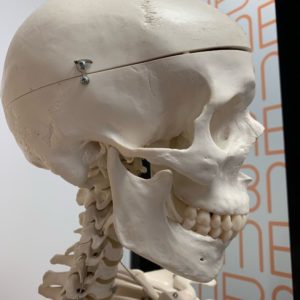The Temporomandibular Joint, also known as TMJ, is a hinge joint connecting the jaw bone to the skull. It is a joint capable of sliding and pivoting to allow for the intricate jaw movements that let us speak, yawn, breathe, pull faces and chew. Like other joints, it can be injured, and hence painful. Have you ever wanted to know more about this intricate joint? Well read on!
TMJ Anatomy
The TMJ is made up of the interaction between the 2 sides of the end of the jaw bone (mandible) and the temporal bone of the skull. It is an interesting joint as both sides of the jaw need to function as one to allow for efficient movement.
Within the TMJ is an articular disc made up of firm connective tissue. This disc sits between each end of the mandible and the skull and allows the two bone ends to move in slightly different ways while we open and close our mouth, both assisting movement, and reducing wear from friction.
TMJ Function
To open our mouth the TMJ needs to slide and pivot at the same time as we hinge our jaw open. Normal mouths open between 4 and 5 cm, depending on our bony make up. One of the interesting functions of the jaw is that we can protrude it forward and backwards as well as open and close, an important combination of movements which allows us to manipulate food in our mouths as we chew.
TMJ Dysfunction
The TMJ, like other joints can get painful and there are many reasons for this. Muscles around the jaw can be injured, the joint can become inflamed, we can have a derangement of the articular disc, and there is the potential for referred pain from other structures to the TMJ like the cervical spine for example.
The most common example of jaw dysfunction is displacement of the articular disc. Think of is as subluxation of the little connective tissue disc from within the joint to outside the joint. This displacement can cause a click or pop with opening and closing, as the disc moves in and out of the joint cavity. This may be associated with pain. Less common are arthritic changes to the joint line. Constantly clenching your jaw adds compression to the joint and if irritable thresholds are reached it can cause significant pain.
If you are suffering from TMJ pain or dysfunction book in to see our Physiotherapists at one of our four Sydney CBD locations. Many of our Physio’s treat TMJ issues.






